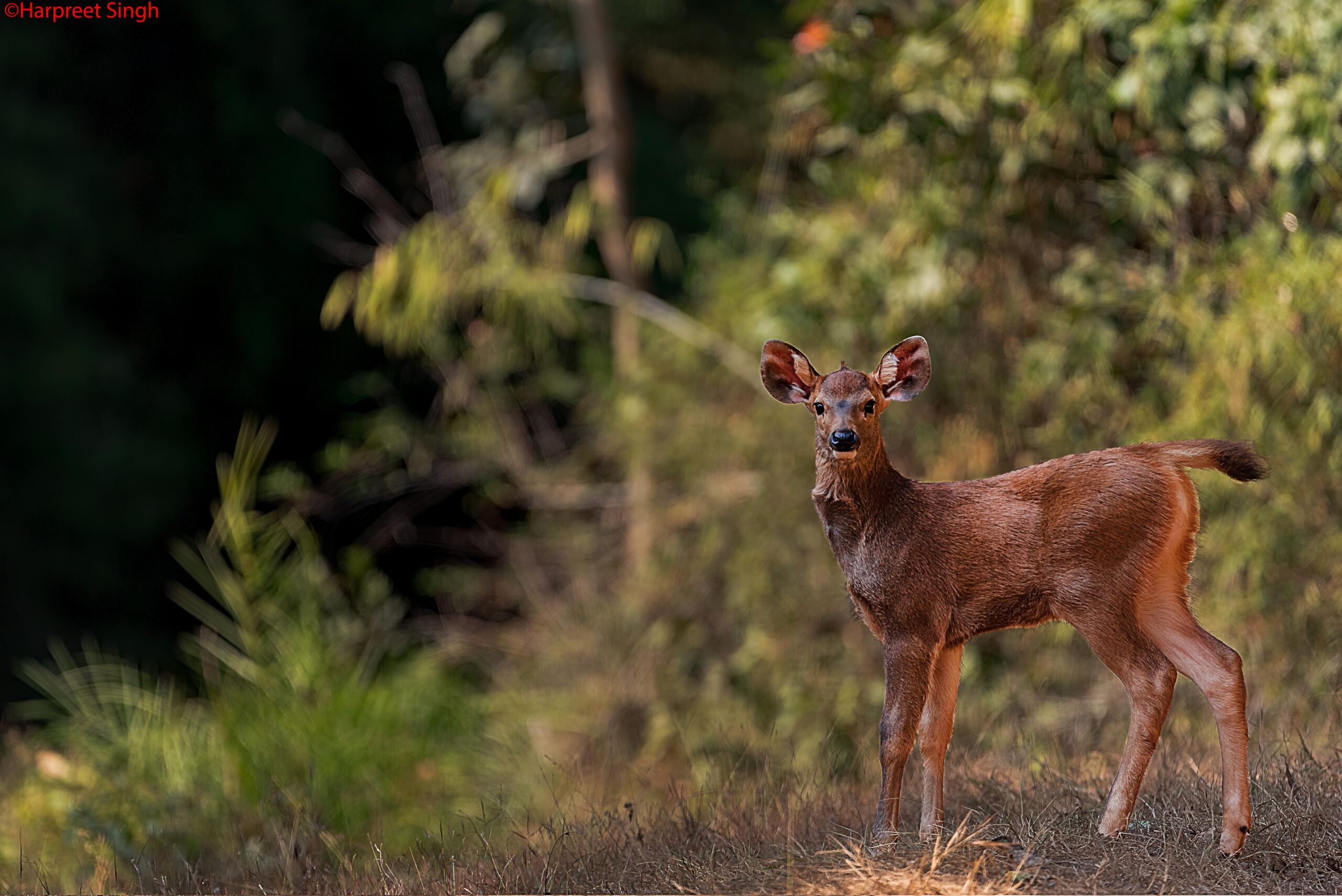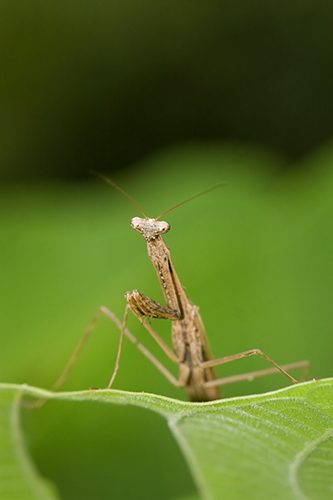
In the age of the National parks, we constantly look for the pristine big cats of India, but more often than not, ignore the prime animal of the jungle which is as important as the big cats: Deer.
One of the most glamorous wild creatures on the planet belongs from the Cervidae Family. Deers come in the order of Artiodactyls (even toed ungulates), and ruminant ungulates, i.e. animals who after swallowing their food regurgitate the semi-solid digested cud to get the maximum food value.
Almost every deer species have one distinct characteristic – the extended appendages on their head called antlers. A gradual process after every shedding it grows once again with a soft, shining, velvety coat finally taking the shape which is the most fascinating feature of this taxon. The antlers are made up of bones and are well fed by blood vessels which make them prone to breakage. Horns are made of keratin. Horns are permanent, while antlers are shed every year.
One of the most successful and widely distributed fauna in the Indian subcontinent, Deers inhabit mostly wooded areas with rugged terrains, scrub forest and grassland.
The evolution of these charismatic species has spanned over 20 million years and is extended over 9 species (in India), which can be broadly classified into two subfamilies: Muntiacinae and Cervinae that later included the subfamilies: Hydropotinae and Odocoileinae.
Let’s take you through a comprehensive journey of these elegant beauties of the wild.
SPOTTED DEER (Axis axis)

This social and arguably the most aesthetically captivating deer is found in India. With a lifespan of 15 to 25 years, these golden-rufous colored deers are the state animal of Telangana. Ranging from the lower parts of Himalayas to south and eastwards till the Gangetic plain, these subtle creatures are widely found in the Indian Subcontinent, and prefer to stay in the grasslands, swampy meadows and scrublands.
Male spotted deer have three pronged lyre-shaped antlers which can grow upto three feet long.
Commonly called as Chital, these elegant ungulates can be seen in a herd of 10 to 50 individuals and are known to associate with langurs, as it helps them to feed on the dropped fruits and leaves. Also their mutually beneficial relationship acts as a warning system if the predator is lurking around. They are adept in warning each other with their alarm calls. Chitals are known to be the robbers of the cultivated fields as they love to feed on the lush green leaves.
Rutting season of chitals differs from area to area, and their rutting calls resound deep in the jungle. Male stags are often seen fighting for their doe and this could turn out to be quite a fierce sight. As deers are the favoured food of predators, their breeding cycle is quite fruitful. They give birth to young ones, after every six months.
Best Seen: Although they are widely spread across India, the best places to find them in large herd are Pench National Park, Kanha National Park, Corbett National Park and Nagarhole National Park.
INDIAN CHEVROTAIN (Moschiola indica)
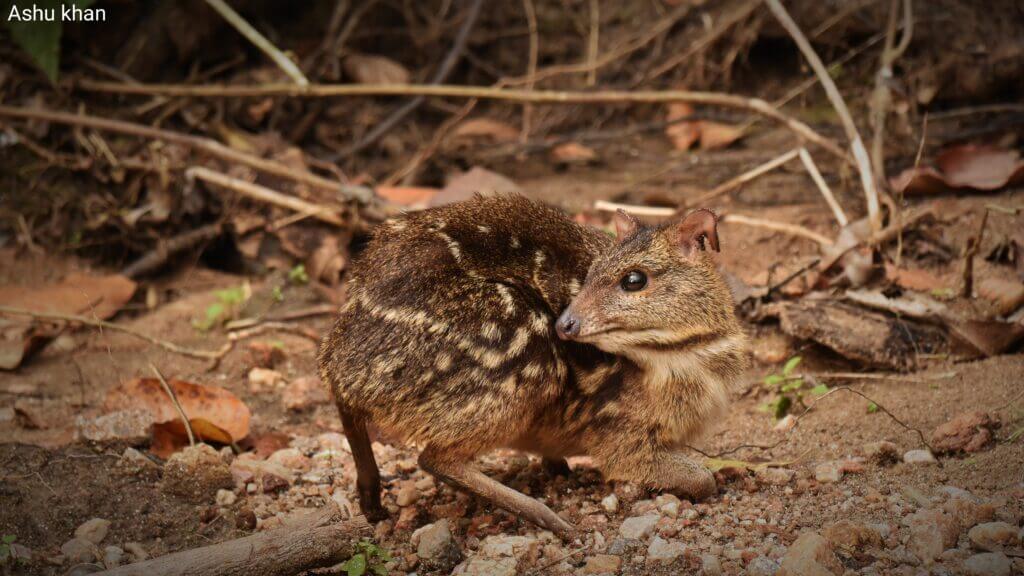
India’s smallest deer, also known as the Mouse deer is endemic to the Indian subcontinent. This shy and solitary ruminant lives a quiet life in the dense forest. This unique deer is spread across the peninsular India, and their habitat ranges from deciduous, semi-evergreen, to evergreen forest. They prefer to stay low-key in the thick undergrowth and though rare to sight, but sometimes sighted close to the riverine areas.
Speckled with which dots on the body, this olive-brown ruminant is 25-30 cm longs and only weighs upto 2 to 4 kilograms. Unlike other ruminants, mouse deer has three chambered stomach, which is one the unique feature of this beautiful species.
As they tend to live in the dense forests, they don’t have antlers, but rather have large canines (mostly visible in males) which probably act as a fighting tool for them.
This extraordinary creature possess many unique behaviours, of which one such behaviour is jaw dropping. Chevrotain are often seen climbing the tree trunk, to make a hollow den to avoid the predators.
Being here in the Indian forest for almost 34 million years, hunting and trapping remains rampant to their lives.
Best Seen: Best places to look for these unique species are Kanha National Parks, Nagarhole National Park and Western Ghats.
HIMALAYAN MUSK DEER (Moschus Leucogaster)

Source: Wikipedia
This enigmatic taxon is a small dog-like ungulate without antlers, weighing up to 12 to 18 kilograms. A mountain ruminant with a sandy brown coat and paler chest, is found all across the Western Himalayas through Himachal Pradesh up to Sikkim. Unlike other deers, this shy creature has a very small home range, and can be found in thick bamboo forests, rhododendron forests and medium to high alpine forests, ranging upto 2500m – 4400 m.
Commonly called White-bellied Musk Deer this species has large canines protruding from the mouth, which when broken grows back easily. They communicate mostly through olfaction (a process of smelling). Males have a scent sac that secretes a substance called musk, which they use to mark their territory and to attract the females. The musk is highly valued in cosmetic industries and has pharmaceutical properties, which makes them vulnerable to poaching, and has wiped out majority of their population.
Being shy and sedentary, it is quite a task to sight these precious species.
Best Seen: Few places where you can get a chance to see them are Govind Pashu Vihar National Park and Sanctuary and Great Himalayan National Park.
There are other species of deer which are found in India which includes The Kashmir Musk deer (Moschus cupreus), a medium sized deer with greyish- brown coat speckled with white dots on the back, and is mainly found in Jammu and Kashmir.
Alpine Musk Deer (Moschus chrysogaster), a large reddish-grey deer with white stockinged legs, are spread all across Central and Eastern Himalayas, Arunachal Pradesh and Sikkim.
The Black Musk Deer (Moschus fuscus), a well distinguished deer with dark brown coat, lacking stripes on the throat, with a small face as compared to other musk deer are spread across North-Eastern Himalayas and Sikkim.
INDIAN OR RED MUNTJAC (Muntiacus muntjak)
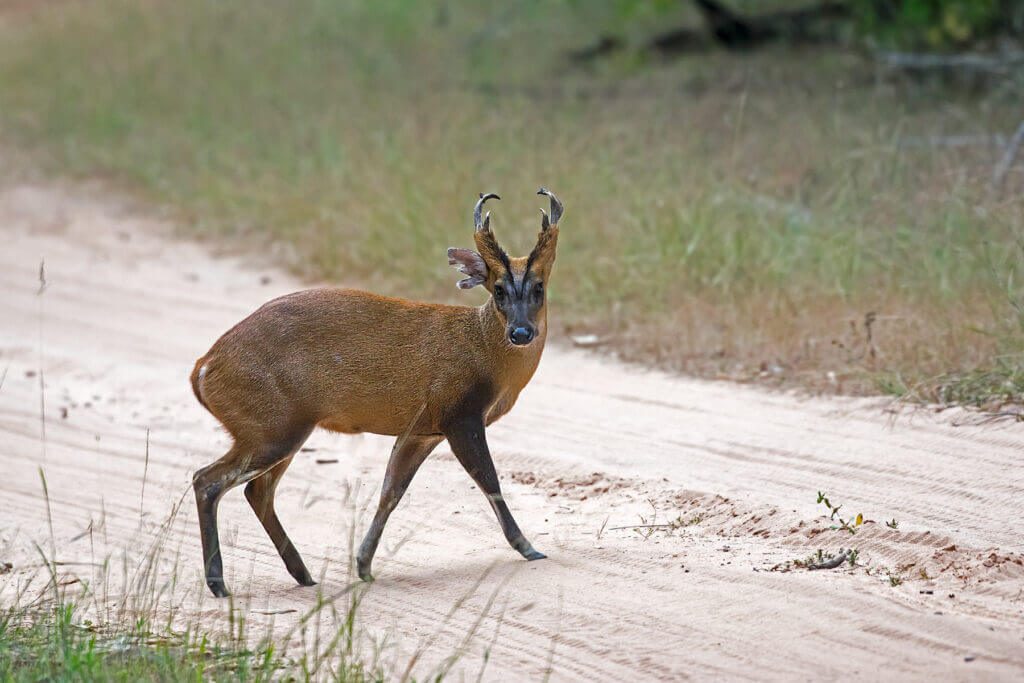
One of the least studied deer of the Indian Subcontinent, this reddish-brown, glossy deer is one of the unique mammal in itself, with the lowest number of recorded chromosomes (males have seven diploid chromosomes and females have six). This anomalous species is not just restricted to rainforest, they are found all across peninsular India and the Terai. Red Muntjac is found in the wet forest of North-East and Western Ghats, and dry scrub forests of Central India.
In Red Muntjacs, males have small tusks and small antlers, and females have bony knobs instead of antlers. This shy species has a home range of 6-8 sq. km that they scent mark regularly, by rubbing their pre-orbital glands (which are placed under the eye) on the branches of a tree. Their call sounds like a barking dog and hence is known as Barking Deer.
Best Seen: Although this rare ruminant is hard to sight, few places in India give a good opportunity to spot them, which include Panna National Park, Satpura National Park and Nagarhole National Park.
SAMBAR DEER (Rusa unicolor)

With the grandest of antlers, Sambar deer is India’s largest forest ruminant, with a dark brown coat, weighing up to 180-270 kilograms. Males have huge three-tined antlers that can grow upto 1 metre long. They are found throughout India, except high Himalayas, desert, kutch and the coast. Their habitat ranges from dry to moist deciduous forest, scrublands to wetlands, tropical evergreen forests, to pine and oak forests. Sambar deer prefers moist habitat but are easily adaptable to the dry areas. This mighty creature is highly territorial and are often seen fighting for their land.
Both male and female have a sore spot on the neck which is a gland that is associated with communication during the rut/mating. Males live a solitary life and are occasionally spotted associating with each other, mostly in the rutting season. Sambar deer have well developed facial glands which are used to attract the females, by scent marking on the tree trunks. They love water therefore, sambar deer are often seen soaking themselves in the shallow lakes and rivers.
Best seen: Since they are shy, they often run when they are near human dominated areas, but few places like Satpura National Park, Kanha National Park, Kaziranga National Park gives a good chance to spot this big species.
KASHMIR RED DEER (Cervus Elaphus)
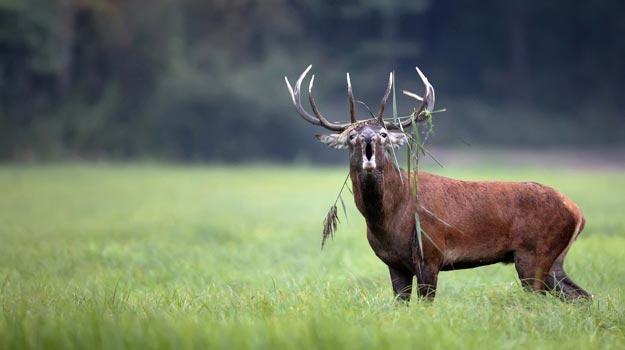
Source: Wikipedia
One of the iconic species, Hangul is the state animal of Jammu and Kashmir and is now classified as a critically endangered species by IUCN. A shabby looking deer with brown coat and orange-white patch at the rump, Kashmir Red Deer is considered as important as the tiger, in the mountains. They blend very well with the surroundings, as their colour varies from season to season, and their movement becomes migratory with the change in season.
These grimy looking deer have fine-tined antlers and are known to roar during the rutting season. Hangul are territorial and like to move around and guard their territory. As the population of the hinds are more as compared to stags, the rutting takes place rarely.
Best Seen: Their habitat differs from moist, broadleaved and coniferous forest and is restricted to Dachigam National Park, Waraghat-Narang and Chandaji Nullah in Jammu-Kashmir.
BROW-ANTLERED DEER (Cervus eldii)
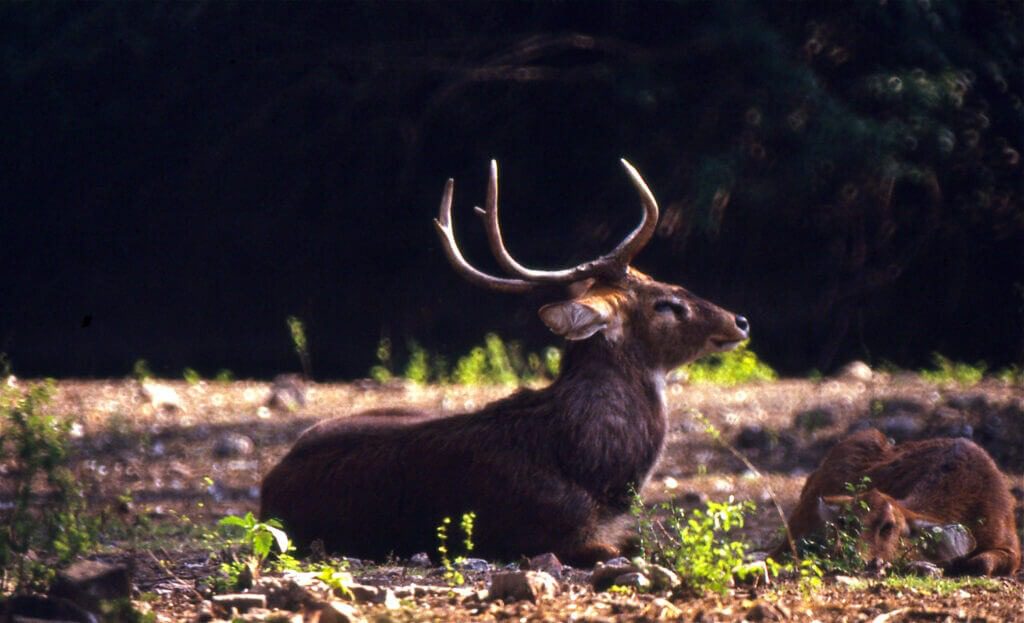
Source: Wikipedia
Also known as the Dancing Deer, this comely looking deer has a very delicate walking pattern, as it hops on the carpet of the grass. Having 2 to 10 tined antlers makes this deer the most extravagant species of the Indian forest. This graceful creature is reddish-brown in colour and becomes paler with the onset of winters.
Often leaving the herd behind, the stags live a solitary life and only appear during the rutting season. Locally known as Thamin, it inhabits open flat grasslands, floating vegetation and avoids forests.
Best Seen: In India their population is restricted to Keibul National Park and Loktak late of Manipur.
SWAMP DEER OR BARASINGA (Cervus duvaucelli)
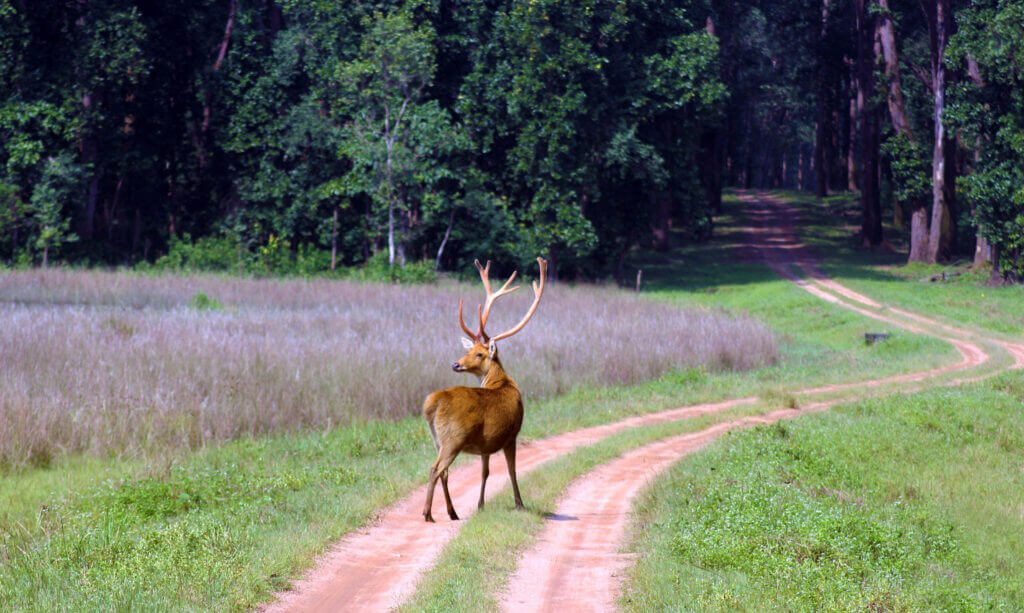
Swamp Deers have a proud story to tell of the Indian forests, as these magnificent species was brought back from the brink of extinction. With 10-12 tined antlers, this spectacular deer with golden to reddish-brown coat are known to be the pride of the Indian jungles. They are picky eaters, as they only feed on one particular grass: Saccharum spontaneum.
There are three different species of Barasingha found in the Indian Subcontinent. One is the Wetland Barasingha, the largest of all the subspecies and is found Nepal and Terai region. Then comes the Hard-ground Barasingha which are restricted to Central India and the third one is the Eastern Barasingha or the Soft-ground Barasingha, the smallest of all the Barasingha’s which are only found in the northeast region of Assam.
They inhabit tall grasslands, reed beds of the large river, alluvial grasslands with swamps and dry grasslands, bordered by sal forest. These astonishing creatures are monoestrous which means having one estrous cycle per year (i.e. giving birth to only one young per year).
Best Seen: Quite vulnerable to poaching, as their area is restricted to grasslands, but few places like Kanha National Park, Satpura National Park, Dudhwa National Park, Kaziranga National Park and Manas National Park give a good chance to spot these incredible species.
HOG DEER (Axis porcinus)
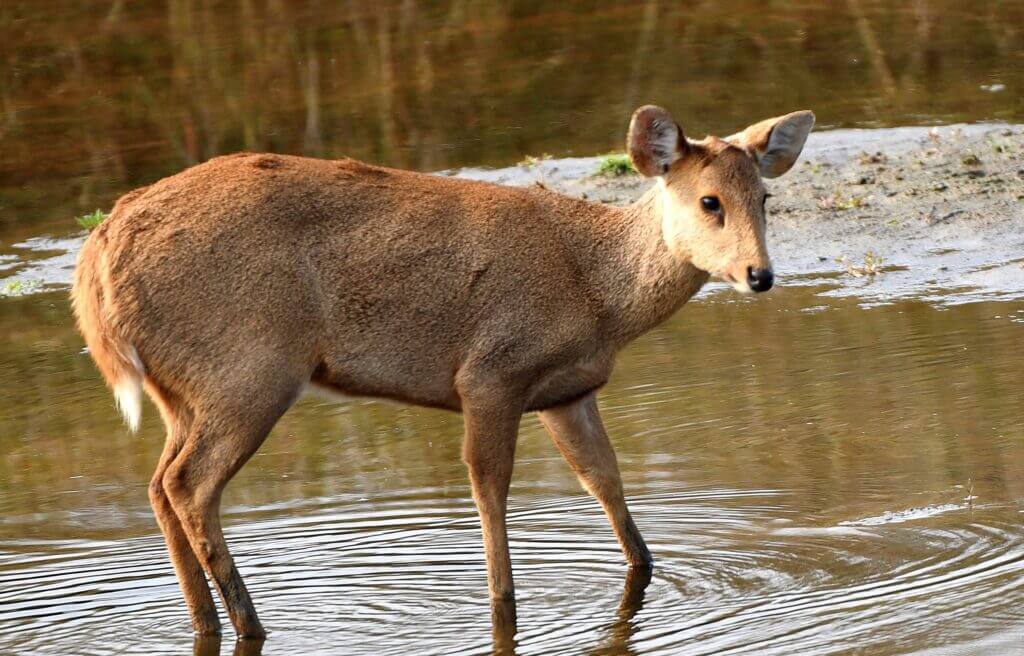
A medium-sized grassland ruminant species that is widely distributed through the plains of Indus River, Ganga and few of its tributaries, from Punjab to Assam and Arunachal Pradesh in the North-East. This stoutly built taxon has a large body with short legs, and does not have long antlers.
Indian hog deer inhabits wet, tall grassland with alluvial soil on the edges of the forest, swamp or riverine areas and avoids dense forest. This solitary creature is always resting and forage mostly in night.
Best Seen: The best places to spot these elusive species are Keibul Lamjao National Park, Kaziranga National Park and Manas National Park.
FACTS ABOUT DEERS
- Mothers usually hide their fawns at safe places, as they do not have a detectable smell.
- Deers have a great vision, as their eyes are placed at the side of the head which gives them a vision of 310 degrees.
- Every species of deer will have different alarm calls, for different predator.
- Deers are opportunistic eaters; not just reeds and grass, they also feed on birds and eggs to complete their protein intake.
- Pudu deer is the world’s smallest deer weighing around 9 kilograms and the largest deer is the Alaskan Moose.
- Deers, after shedding their antlers ingest them as they are filled with Calcium, phosphorous and salt. Even others animals like foxes, squirrels and porcupine eat their shed antlers.
Written By: Himani Singh Chouhan, Naturalist at Denwa Backwater Escape, Satpura
Edited by: Natasha Sinha, Content Curator, Pugdundee Safaris
Contact us for bespoke safari experiences.
Email : [email protected] [email protected] Call : +91-11-4013 6332.
Kanha Earth Lodge – Resort in Kanha | Pench Tree Lodge – Pench
Kings Lodge resort-in-bandhavgarh & Tree House Hideaway – Bandhavgarh
Ken River Lodge – Panna | Denwa Backwater Escape – Resort in Satpura

